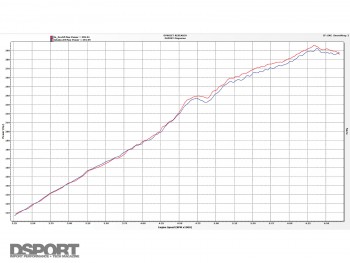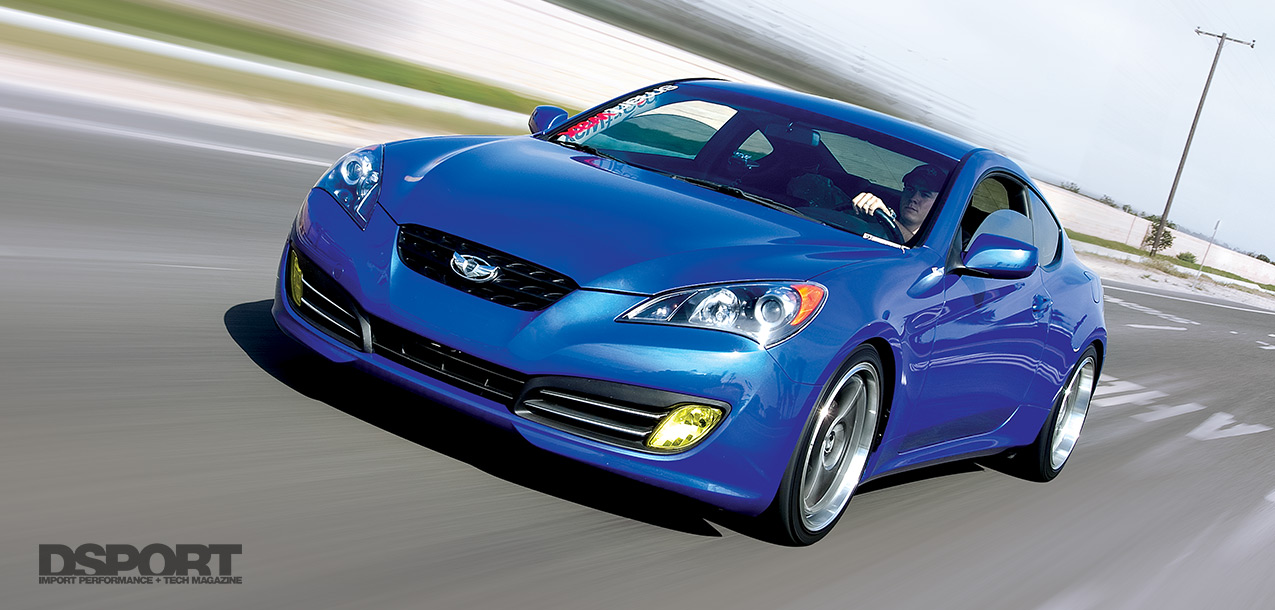The Dyno
In stock trim, our Hyundai Genesis was strapped onto the Dynojet dynamometer at MD Automotive. After a few warm up runs, the bone-stock Genesis settled at 280.66 whp. Hyundai claims the Lambda RS 3.8 generates a 305 horsepower. However, 280whp equates to 330 horsepower at the flywheel. Obviously, Hyundai underates the Genesis significantly.
280.66 WHP
260 LB-FT TQ
Test 1: Injen Cold-Air Intake
With a baseline established, installation of the cold air intake commenced. While the stock intake comes out with a few loosened clamps and bolts, installation of the Injen cold-air intake required the front bumper be taken off and the windshield washer fluid bottle be replaced with the unit supplied by Injen. With the front bumper out of the way, the rest of the Injen cold-air intake bolts in easily. After reinstalling the front bumper, the Coupe hit the dyno once again and produced 291.99 peak whp.
291.99 WHP
264.08 LB-FT TQ
The Injen Cold-air Intake delivers some serious performance gains. Improvements take hold at 4,500RPM and really get going from 6,000RPM to redline.
Test 2: Injen Cat-Back Exhaust System
After allowing time for the exhaust components to cool, the fasteners received a saturation of rust penetrant before being broken loose with tools. This not only makes the job easier but also reduces the chance of damage to the fastener’s threads. The exhaust installation required only simple hand tools. With the cat-back system in place, the Hyundai Coupe was strapped back onto the dyno. The exhaust system showed measurable power gains from 4,500 RPM to redline. With the Injen cat-back exhaust in place, the Genesis produced 295.51 peak wheel horsepower, a gain of 3.52 horsepower. The exhaust system also produced a clean low rumble without excessive noise levels at any RPM range.
295.51 WHP
267.27 LB-FT TQ
The Injen Cat-Back exhaust system also showed its best gains from 4,500RPM until redline. While peak horsepower only increased by 3.5, gains as high as 6.0 horsepower were realized at certain engine speeds.
Test 3: Road Race Motorsports Cat-Delete Pipes
The Coupe was allowed to cool down once again before installing the cat-delete pipes. Our cat- delete pipes looked to have suffered some shipping damage so we first ground the flanges flat on a belt sander. After that, we simply removed the factory cats and replaced them with the delete pipes. The coupe started back up and a difference in exhaust note became instantly noticeable. While the noise level increase at idle wasn’t drastic, the wide-open throttle note could definitely be heard. With the cat-delete pipes in place, peak horsepower at the wheels rose to 297.48. This marginal gain indicates that the factory cats have a pretty good flow potential in the 300 wheel horsepower range. At higher power levels, the cat-delete pipes would likely deliver higher gains.
297.48 WHP
265.64 LB-FT TQ
Factory catalytic converters can often choke off some serious performance. The Hyundai Genesis Coupe 3.8 has some high-flowing stock cats as the Road Race Motorsports cat-deletes managed a peak horsepower gain of just 2.0 horsepower.


